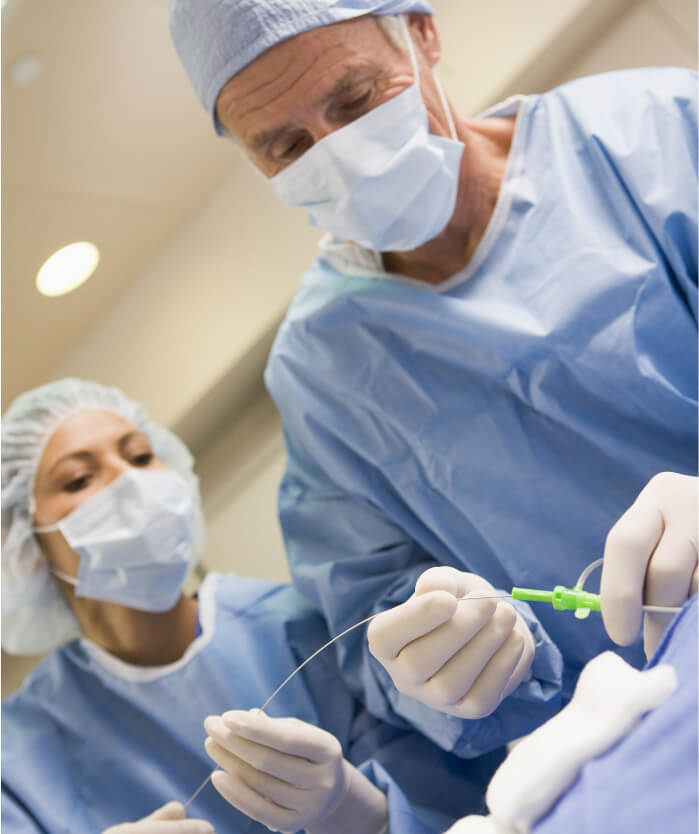TauroPace™ in rhythm surgery
Conditions and treatments
Cardiac implantable electronic devices (CIEDs) – i.e. types of pacemakers or defibrillators – are often necessary to treat arrhythmic conditions in patients.
When do you need a pacemaker or an implantable defibrillator?
Irregular heartbeats that require the implantation of a CIED can occur in many different forms. All of these forms may become clinically symptomatic when the heart fails to supply the body’s organs with blood. The most common diagnoses include:
Condition
For an average healthy adult, the heart rate ranges between 60 to 100 per minute at rest. In case of bradycardia, the rate remains below 60 per minute (which might be normal for highly trained individuals, e.g. professional athletes).
Symptoms
- shortness of breath
- fatigue
- dizziness
- fainting
- (all either during everyday activities or while resting)
Causes / risk factors
- heart tissue damage (e.g. coronary artery disease, heart failure, valve impairment, cardiomyopathy)
- prescription of special medication
- age above 64 years
- recent cardiac surgery
Treatment
A permanent pacemaker is the most common therapy for symptomatic bradycardia.
Condition
Patients suffering from tachycardia (also known as tachyarrhythmia) have an average heartbeat that exceeds 100 – or in some cases even 200 – per minute at rest.
Symptoms
- shortness of breath
- fatigue
- dizziness
- fainting
- stenocardia (chest pain or discomfort)
Causes / risk factors
- high blood pressure (arterial hypertension)
- heart tissue conditions (e.g. coronary artery disease, cardiomyopathy, valvular impairment, heart failure, myocarditis)
- vessel disease (e.g. atherosclerosis, pulmonary arterial hypertension)
- thyroid gland impairment
- chronic pulmonary disease
- renal impairment
- psycho-emotional stress
- substance abuse (alcohol/drugs)
- excessive caffeine intake
- smoking
Treatment
In some cases, an implantable cardioverter defibrillator (ICD) can be an option to treat tachycardia.
Condition
Inability of the heart to pump blood in a sufficient amount.
Symptoms
- shortness of breath
- fatigue
- fainting
- coughing with produce
- swollen legs and feet (as a result of venous pooling of the blood which cannot be sufficiently forwarded)
- nocturia (waking up frequently at night to urinate)
Please note: Acute onset of heart failure (with symptoms such as shortness of breath, dizziness, and fainting) is oftentimes detected rather quickly. In cases of chronic heart failure though, symptoms can become noticeable gradually over time, which might delay the process of diagnosis and subsequent treatment.
Causes / risk factors
Heart failure is a result of structural damage and usually develops somewhat slowly. Acute heart failure can also be triggered by a heart attack. Circumstances that may put patients at greater risk include:
- high blood pressure (arterial hypertension)
- coronary artery disease and heart attack (myocardial infarction)
- innate or acquired valve impairment
- congenital heart defect
- heart tissue defect (cardiomyopathy)
- infection of the heart (endocarditis)
- inflammation of the heart tissue (myocarditis)
- family history of cardiac diseases
- diabetes
- any type of irregular heartbeat (cardiac arrhythmia)
Treatment
Depending on the level of impairment, heart failure might be treated with the implantation of a special pacemaker device.
Condition
Due to a momentary lack of perfusion in the cortex, patients will lose consciousness (and often injure themselves in the process). It can happen either once or recurrently and might thus severely impair a patient’s quality of life.
Symptoms
- dizziness
- fainting
- nausea
- lack of orientation
- sweating
- blurred vision
Causes / risk factors
1. Reflex syncope
A neuronal reflex leads to a sudden decrease of the median arterial pressure, followed by a slowed-down heartbeat. This can be triggered by:
- strong sense of fear or pain
- visual stimulus or bad odor
- prolonged upright position (standing for a long time)
- psycho-emotional stress
2. Orthostatic syncope
A rapid movement switching from lying down to sitting or standing upright leads to venous pooling and lack of oxygen in the cortex. This can be triggered by lack of hydration.
3. Cardiac syncope
In some cases, an arrhythmic condition (i.e. irregular heartbeat) may also result in a loss of consciousness or even sudden cardiac arrest.
Treatment
If cardiac arrhythmia is the underlying disease and other therapies prove obsolete, syncope might require the implantation of a pacemaker or even defibrillator.


